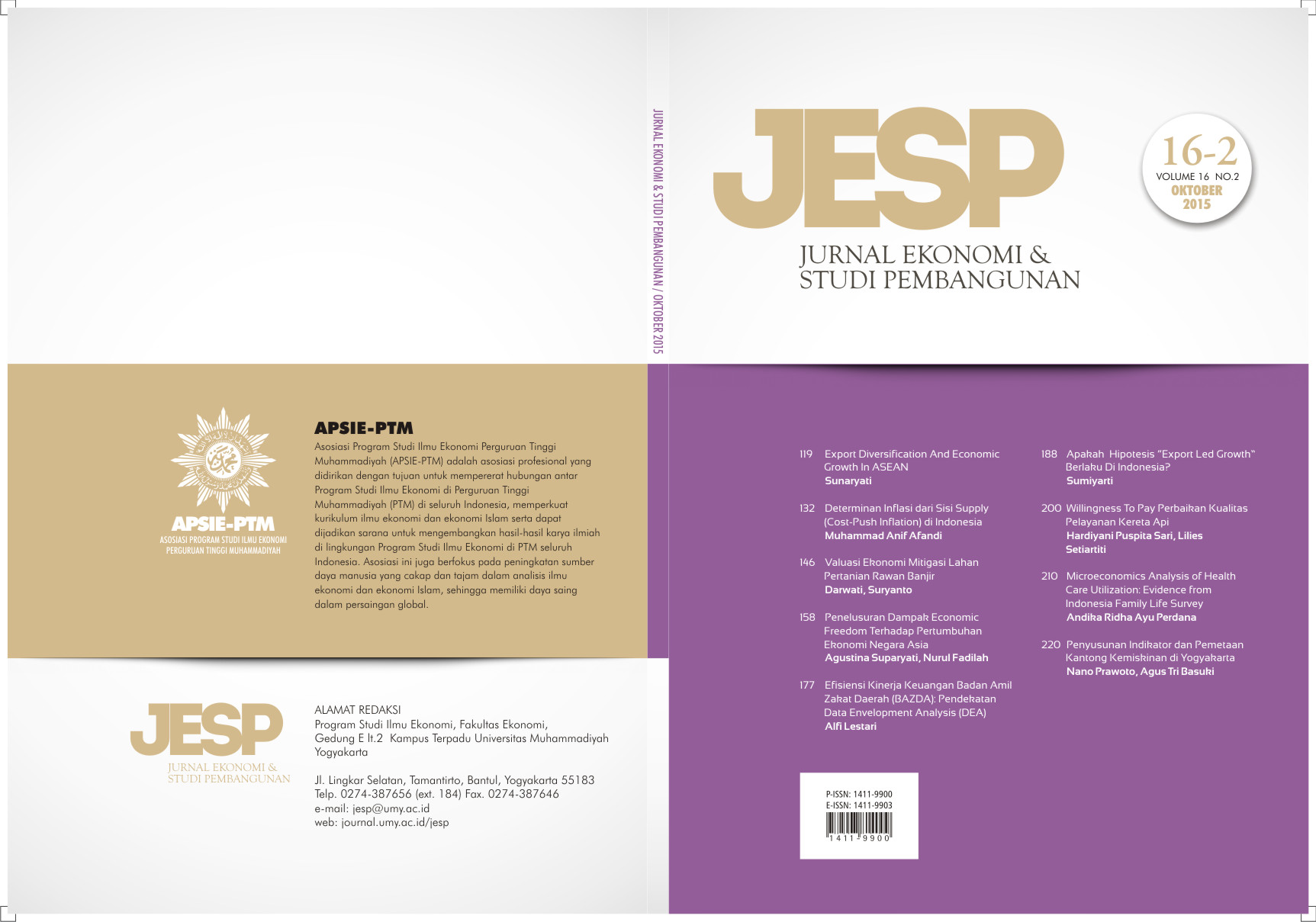EXPORT DIVERSIFICATION AND ECONOMIC GROWTH IN ASEAN
Keywords:
export diversification, economic growth, causality, ASEANAbstract
Abstract: This paper tries to assess empirically the relationship between export diversification and economic growth on selected countries in ASEAN. Using annual data or time-series over the period 1989 to 2010 and econometric techniques (Granger causality and cointegration) are applied to test the relationship between export diversification and economic growth. The result show that, in case of Indonesia and Malaysia, there are exist uni-directional causality from GDP to export diversification. For Singapore and Thailand, the results show that there are no causal relationship between export diversification and economic growth.
Abstrak: Tulisan ini mencoba mengkaji secara empiris hubungan antara diversifikasi ekspor dan pertumbuhan ekonomi di negara yang dipilih di ASEAN. Dengan menggunakan data tahunan atau time series selama periode 1989 sampai 2010 dan teknik ekonometrik (Granger kausalitas dan kointegrasi) yang diterapkan untuk menguji hubungan antara diversifikasi ekspor dan pertumbuhan ekonomi. Hasil penelitian menunjukkan bahwa, dalam kasus Indonesia dan Malaysia, ada ada uni-directional kausalitas dari PDB untuk diversifikasi ekspor. Untuk Singapura dan Thailand, hasil menunjukkan bahwa tidak ada hubungan sebab akibat antara diversifikasi ekspor dan pertumbuhan ekonomi.
References
Agosin, M. P. (2007). Export diversification and growth in emerging economies, Working Paper No.233. Universidad de Chile: De¬partmento de Economia.
Al Marhubi, F. A. (2000). Export diversification and growth: an empirical investigation. Applied Economics Letters, 7: 559-562.
Amin Gutiérrez de Piñeres, Sheila, and Michael J. Ferrantino. (1997a). Export diversifi¬ca¬tion and structural change: some com¬parisons for Latin America. The Interna¬tional Executive, Vol. 39 No. 4, July/Au¬gust: 465-477.
Arip, Mohammad Aendy, Yee, Lau Sim and Abdul Karim, Bakri. (2010). Export diversification and economic growth in Malaysia, MPRAWorking Paper No. 20588.
ASEAN Development Bank. Key indicator for Asia and Pacific, (2011).
Engle, R. F., & Granger, C. W. J. (1987). Cointe¬gration and error correction: represen¬ta¬tion, estimation, and testing. Eco¬nomet¬rica, 55: 251-276
Hall, S. G. (1989). Maximum likelihood estima¬tion of cointegrating vectors: An Example of Johansen’s Procedure. Oxford Bulletin of Economics and Statistics, 51: 213-218.
Hesse, H. (2008). Export diversification and eco¬nomic growth, Working Paper No. 21. the Commission on Growth and Develop¬ment.
Herzer, D., & Lehmann, N. (2006). What does export diversification do for a growth? An Econometric Analysis. Applied Econo¬mic Letters, 38(15): 1825-1838.
International Monetary Fund. (2012). World Economic Outlook Database.
Johansen, S. and Juselius, K. (1990). Maximum likelihood estimation and inference on cointegration with applications to the demand for money. Oxford Bulletin of Economics and Statistics.
Kenji, Y., & Mengistu, A. A. (2009). The impacts of vertical and horizontal export diversi¬fication on growth: an empirical study on factors explaining the gap between Sub-Sahara Africa and East Asia's Per¬formances. Ritsumeikan International Af¬fair, 17: 41.
Klinger, Bailey and Daniel Lederman. (2004): Discovery and development: an em¬pirical exploration of “new” products. Policy Research Working Paper No. 3450, World Bank, November.
Krugman, P. (1980). Scale economies, product differentiation, and the pattern of trade. The American Economic Review, 70(5): 950.
Krugman, P., & Obstfeld, D. 2003). International economics: theory and policy (754, Trans. 6th ed.). Boston: Pearson Education, Inc.
Masih, A. M. M., & Masih, R. (1999). Are ASEAN stock market fluctuations due mainly to intra-regional contagion ef¬fects? Evidence Based on ASEAN Emerging Stock Markets, Pacific-Basin Finance Journal, 7, 251-282.
Michaely, M. (1977). Exports and growth: an empirical investigation. Journal of Devel¬opment Economics 4: 49-53.
Moschos, D. (1989). Export expansion, growth and the level of economic development: an empirical analysis. Journal of Develop¬ment Economics, 30: 93-102.
Toda, H. Y., & Phillips, P. C. B. (1993). Vector autoregression and causality. Economet¬rica, 59: 229-255.
World Bank. (2011). The World integrated trade solution: Trade Indicator.

Downloads
Published
How to Cite
Issue
Section
License
License
You are free to:
- Share — copy and redistribute the material in any medium or format
- Adapt — remix, transform, and build upon the material for any purpose, even commercially.
The licensor cannot revoke these freedoms as long as you follow the license terms.
Under the following terms:
- Attribution — You must give appropriate credit, provide a link to the license, and indicate if changes were made. You may do so in any reasonable manner, but not in any way that suggests the licensor endorses you or your use.
- ShareAlike — If you remix, transform, or build upon the material, you must distribute your contributions under the same license as the original.
- No additional restrictions — You may not apply legal terms or technological measures that legally restrict others from doing anything the license permits.

Creative Commons License
This work is licensed under a Creative Commons Attribution-ShareAlike 4.0 International License.

